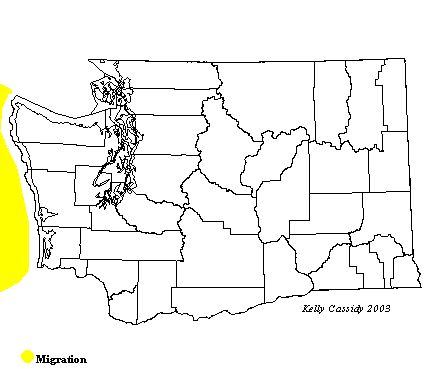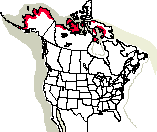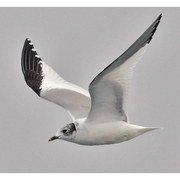Sabine's Gull
The Washington representatives of this family can be split into two groups, or subfamilies. The adaptable gulls are the most familiar. Sociable in all seasons, they are mainly coastal, but a number of species also nest inland. Many—but not all—are found around people. Gulls have highly variable foraging techniques and diets. Terns forage in flight, swooping to catch fish or insects. They dive headfirst into the water for fish. Although they are likely to be near water, they spend less time swimming than gulls.
General Description
The Sabine's Gull is a small gull with a graceful, tern-like flight. This gull has a slate-gray back, a white belly and tail, and black wingtips. The adult has a black bill with a yellow tip. The middle of the wings is white, giving the bird a distinctive 'M' pattern across its wings in flight. In breeding season, the adult has a dark gray hood, edged in black. The adult in non-breeding plumage has a partially gray and white head. The juvenile is brown across the back, neck, and head, with a white face.
Habitat
Sabine's Gulls nest in the high Arctic in marshy tundra ponds close to the coast. Outside the breeding season, they spend most of their time at sea, out of sight of land. When at sea, they concentrate over the continental shelf or over upwellings of cold, nutrient-rich water.
Behavior
The Sabine's Gull often hovers low over the water, dropping down to take food from the water's surface without landing. It also forages while swimming. In summer, this gull often feeds by walking along the tidal flats and picking up food. The Sabine's Gull has been known to spin in circles in shallow water, stirring up food from the bottom.
Diet
In summer, the Sabine's Gull feeds mostly on insects and aquatic insect larvae. During migration, small crustaceans, fish, and other sea creatures are also part of the diet. Their winter diet is not well known.
Nesting
Nests are located on the open ground, in small colonies, typically close to the water. Sabine's Gull colonies are often located near or within Arctic Tern colonies. The nest is a shallow depression, sometimes unlined, or lined with seaweed, moss, or feathers. The female typically lays two eggs, which both parents help incubate for about 3½ weeks. Shortly after the young hatch, the parents lead them to water, where they mostly feed themselves.
Migration Status
Sabine's Gulls nest in the high Arctic, migrate south off the Pacific Coast, and spend the winter as far south as Central Chile. The spring migration lasts from early April to early June. Birds start heading south in late July. The peak of the fall Sabine's Gull migration lasts from late August to mid-September.
Conservation Status
Their remote breeding range and seagoing nature may have protected the population, however the possibility of oil-drilling in the Arctic threatens the Sabine's Gull's nesting habitat. During migration and winter, they are vulnerable to water pollution and fluctuations of prey abundance. Since their winter diet is not well known, more research is needed to fully understand what is necessary for conservation.
When and Where to Find in Washington
Most records for Sabine's Gulls are offshore, and pelagic birding trips give birders the best chance of spotting them. However, juveniles and adults can both be found inland, and sightings, though rare, are so regular in fall that a small percentage of the population must use an overland migration route. The best time of the year to look for Sabine's Gulls is during migration, when they are common on the open water--May for spring migration and the second half of August and September for fall migration. They are uncommon in June and July, and in October, and very rare or absent the rest of the year. They are occasionally blown towards shore in storms and can sometimes be found in the Strait of Juan de Fuca. Juvenile birds are found inland rarely on both sides of the Cascades.
 Abundance
Abundance
| Ecoregion | Jan | Feb | Mar | Apr | May | Jun | Jul | Aug | Sep | Oct | Nov | Dec |
|---|---|---|---|---|---|---|---|---|---|---|---|---|
| Oceanic | F | C | U | F | F | C | F | |||||
| Pacific Northwest Coast | ||||||||||||
| Puget Trough | ||||||||||||
| North Cascades | ||||||||||||
| West Cascades | ||||||||||||
| East Cascades | ||||||||||||
| Okanogan | ||||||||||||
| Canadian Rockies | ||||||||||||
| Blue Mountains | ||||||||||||
| Columbia Plateau | R |
Washington Range Map

North American Range Map


Family Members
 Laughing GullLarus atricilla
Laughing GullLarus atricilla Franklin's GullLarus pipixcan
Franklin's GullLarus pipixcan Little GullLarus minutus
Little GullLarus minutus Black-headed GullLarus ridibundus
Black-headed GullLarus ridibundus Bonaparte's GullLarus philadelphia
Bonaparte's GullLarus philadelphia Heermann's GullLarus heermanni
Heermann's GullLarus heermanni Black-tailed GullLarus crassirostris
Black-tailed GullLarus crassirostris Short-billed GullLarus canus
Short-billed GullLarus canus Ring-billed GullLarus delawarensis
Ring-billed GullLarus delawarensis California GullLarus californicus
California GullLarus californicus Herring GullLarus argentatus
Herring GullLarus argentatus Thayer's GullLarus thayeri
Thayer's GullLarus thayeri Iceland GullLarus glaucoides
Iceland GullLarus glaucoides Lesser Black-backed GullLarus fuscus
Lesser Black-backed GullLarus fuscus Slaty-backed GullLarus schistisagus
Slaty-backed GullLarus schistisagus Western GullLarus occidentalis
Western GullLarus occidentalis Glaucous-winged GullLarus glaucescens
Glaucous-winged GullLarus glaucescens Glaucous GullLarus hyperboreus
Glaucous GullLarus hyperboreus Great Black-backed GullLarus marinus
Great Black-backed GullLarus marinus Sabine's GullXema sabini
Sabine's GullXema sabini Black-legged KittiwakeRissa tridactyla
Black-legged KittiwakeRissa tridactyla Red-legged KittiwakeRissa brevirostris
Red-legged KittiwakeRissa brevirostris Ross's GullRhodostethia rosea
Ross's GullRhodostethia rosea Ivory GullPagophila eburnea
Ivory GullPagophila eburnea Least TernSternula antillarum
Least TernSternula antillarum Caspian TernHydroprogne caspia
Caspian TernHydroprogne caspia Black TernChlidonias niger
Black TernChlidonias niger Common TernSterna hirundo
Common TernSterna hirundo Arctic TernSterna paradisaea
Arctic TernSterna paradisaea Forster's TernSterna forsteri
Forster's TernSterna forsteri Elegant TernThalasseus elegans
Elegant TernThalasseus elegans

